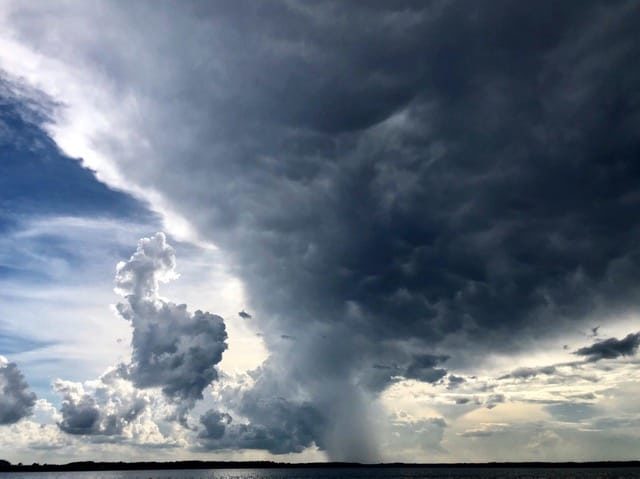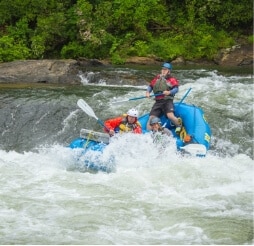Don’t let bad weather take you by surprise!
Lightning, torrential rain, and rough seas can turn a pleasurable outing into a life threatening ordeal in a heartbeat. Yet unwary boaters are too often taken by surprise, largely because they don’t realize just how fast a storm can come up, or the danger it presents.
According to Coast Guard accident data, nearly three percent of all recreational boating accidents are directly related to severe weather conditions that can quickly overwhelm smaller craft. Some thunderstorms, for example, create microbursts—intense downdrafts over an area a half mile to three miles wide— capable of producing wind gusts from 60 mph to more than 100 mph. Microbursts can capsize a small boat or blow a passenger overboard.
No one wants to end up a statistic. The risks of swamping, capsizing, falling overboard, or hitting a floating object all increase in stormy weather; so out on the water the most important equipment on board is always a Coast Guard-approved life jacket for all passengers and a plan to err on the side of caution. Careful attention to marine weather forecasts and staying alert to sudden changes can help keep both good times and safety at a maximum.
Most boaters already know to track the extended five-day forecast on local AM/FM radio and television or internet weather sites like the National Oceanographic and Atmospheric Administration’s (NOAA) Marine Forecast and information web page at www.weather.gov/om/marine/home.htm.
At larger marinas, small craft advisories, storm warnings, and other alerts warn boaters of higher wind and waves, either imminent or expected within the next 24 hours.
Once on the water, technology has given operators of even very small boats an edge. VHF-FM weather radios or VHF transceivers with built-in NOAA weather radio channels are readily available at most retail outlets, with HF single sideband transceivers as a backup for those ranging farther out on the water.
Monitoring the latest weather reports can warn boaters if conditions are right for severe weather. But knowing there’s a chance of a thunderstorm won’t tell you when one is headed your way. Weather fronts typically move in from the west/southwest, so scanning the horizon in that direction periodically can pick-up far-off lightning flashes and other signs.
Being able to recognize storm cloud patterns is also a useful skill. A “lowering ceiling”—flat clouds getting lower and thicker—means an approaching storm front. A hot, humid day frequently means thunderstorms as radiant heat from the land picks up moisture from the water and puffy, vertical clouds grow into thunderheads. Result: a violent squall, accompanied by a sudden drop in temperature, sharp winds, suddenly heavier seas, and an increased risk of those micro-bursts we talked about.
Bottom line: weather can be both friend and foe. Boaters who stay alert to weather changes and take appropriate action go a long way toward safeguarding their property and the lives of everyone on board.
Things to look for that indicate an approaching weather front:
- Flat clouds getting lower and thicker
- Puffy, vertically rising clouds getting higher
- Dark, threatening clouds, especially to the west/southwest
- A sudden drop in temperature
- A halo around the sun or moon
- Increasing wind or a sudden change in wind direction
- Flashes on the horizon
- Seas becoming heavy
- Heavy AM radio static, indicating nearby thunderstorm activity
What to Do in Severe Weather:
- Reduce speed, keeping just enough power to maintain headway
- Make sure everyone on board is wearing a life jacket
- Turn on your running lights
- If possible, head for the nearest shore that is safe to approach
- Head the boat into the waves at a 45 degree angle
- Keep the bilges free of water
- Seat any passengers on the bottom of the boat, near the centerline
- If the engine fails, trail a sea anchor from the bow of the boat to keep it headed into the waves (a bucket can work as a sea anchor in an emergency)
- Anchor the boat if necessary
Article by Sue Dragoo, Public Relation Officer with America’s Boating Club®
Reference: Joseph Carro, U.S. Coast Guard, Boating Safety Division
- Tags: Lakes
-
Post Author: Chanda Morrison












